Melted spatulas, scratched pans, and broken handles—bad utensils make cooking harder than it needs to be.
The best silicone cooking utensils are heat-resistant, non-toxic, non-scratch, and durable—perfect for protecting cookware and making everyday cooking easier.
After years of trial and error in my home kitchen, I realized the right tools don’t just make cooking smoother—they actually protect your cookware and save you money. Whether you’re flipping pancakes or stirring soup, here’s everything you need to know about choosing the best silicone cooking utensils.
Why Choose Silicone Utensils Over Plastic or Metal?
Some utensils melt. Others scratch your pans. Silicone avoids both problems and lasts longer.
Silicone cooking utensils are flexible, durable, and heat-resistant, making them ideal for non-stick pans and high-heat cooking.
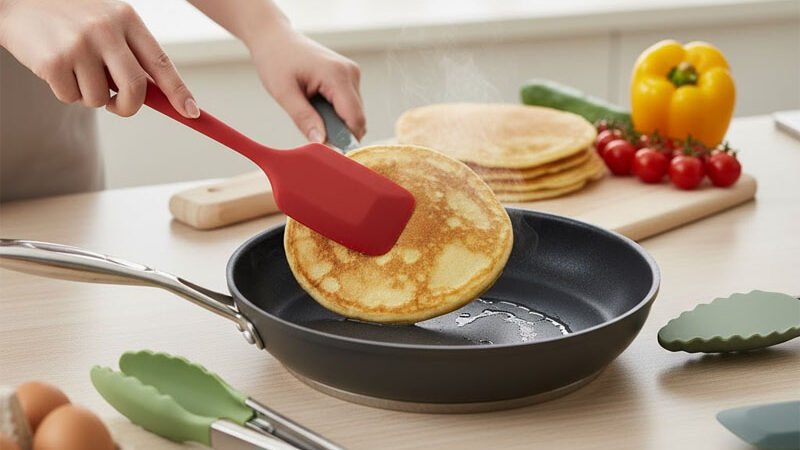
Plastic tools melt and warp. Metal tools scratch your cookware. I learned this the hard way when a metal whisk ruined my favorite non-stick pan. After that, I switched to silicone. Silicone withstands temperatures up to 230–260°C (450–500°F), so it won’t melt in a hot pan.
Unlike plastic, silicone doesn’t leach chemicals when exposed to heat. It’s also more flexible, making it better for scraping, folding, and stirring. Most importantly, it doesn’t scratch non-stick surfaces, enamel, or cast iron.
What Should a Good Silicone Utensil Set Include?
Not every tool is worth the drawer space. A good set includes only what you’ll use daily.
A quality silicone utensil set includes a spatula, spoon, ladle, turner, tongs, and whisk—each with a sturdy core and food-grade silicone coating.
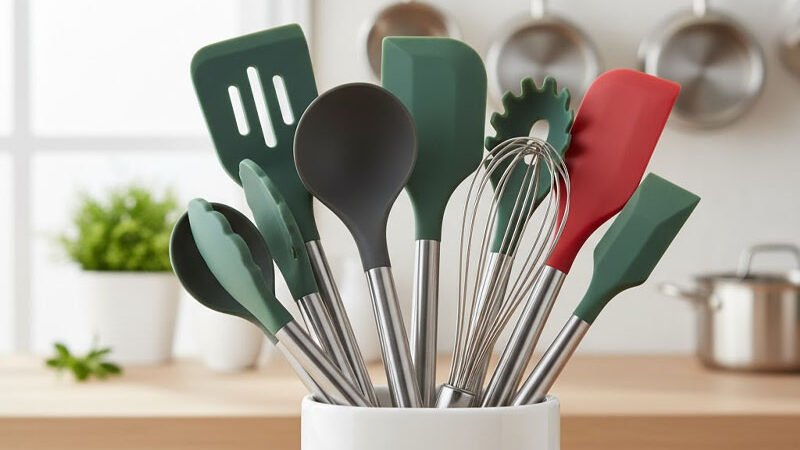
Here’s what I always recommend in a core set:
| Tool | Why You Need It |
|---|---|
| Spatula | For baking, scraping bowls, and folding batters |
| Slotted Turner | For flipping pancakes, eggs, or fish |
| Solid Spoon | For mixing stews or sauces |
| Ladle | For serving soups and curries |
| Whisk | For beating eggs or blending sauces |
| Tongs | For grilling, flipping meat, or serving pasta |
Choose utensils with a stainless steel or nylon core for strength. The silicone should be seamless, not glued, to prevent breakage and bacteria buildup.
Are All Silicone Utensils Food-Safe?
Some products labeled “silicone” include fillers that aren’t safe when heated.
Only 100% food-grade silicone is safe for cooking. Always check for FDA or LFGB certification to ensure your utensils won’t leach harmful chemicals.
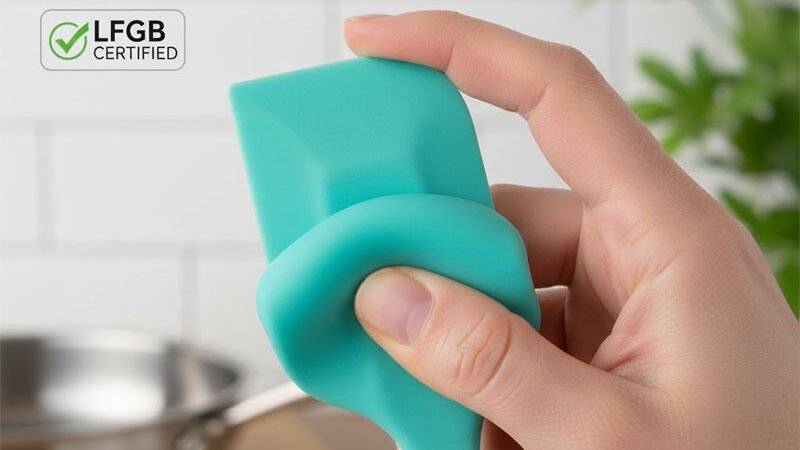
When I first bought silicone utensils, I didn’t know the difference. Some had a rubbery smell when heated. Later, I learned they included fillers, not pure silicone. Food-grade silicone should be odorless, non-reactive, and stable under heat.
Look for certifications like FDA (U.S.) or LFGB (Europe). These standards confirm the silicone won’t break down or release toxins when exposed to heat. At RuiYang, we only use certified silicone in our cooking products to ensure they’re safe for families and professionals alike.
You can also do a pinch test—bend the silicone and see if white shows through. That means fillers are present.
What Makes Silicone Utensils So Durable?
Wood cracks. Plastic warps. Cheap utensils break after a few months. Silicone just keeps going.
Silicone utensils last longer because they resist heat, stains, and cracking. With a solid core, they can handle heavy-duty kitchen tasks.
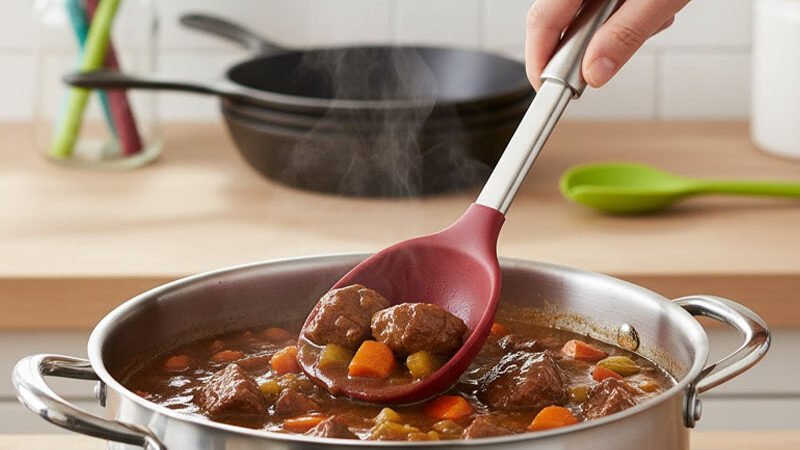
I’ve had the same silicone ladle for over five years. It hasn’t melted, cracked, or faded. Unlike wood, silicone doesn’t absorb liquids or odors. Unlike plastic, it doesn’t stain from tomato sauce or turmeric. And unlike metal, it doesn’t rust or dent.
What makes silicone so reliable is its ability to bounce back to shape. Stir thick dough or flip a roast—silicone holds up. Most professional kitchens now include silicone tools because they reduce wear on cookware while surviving constant use.
If you buy high-quality, seamless silicone utensils with a strong inner core, they’ll outlast most other tools in your kitchen.
How Do You Clean and Store Silicone Utensils?
No one likes scrubbing sticky sauce off wooden spoons. Luckily, silicone makes cleanup easy.
Silicone utensils are dishwasher-safe, stain-resistant, and don’t trap food particles. Store them in a holder or hang them by their loops to keep them clean.
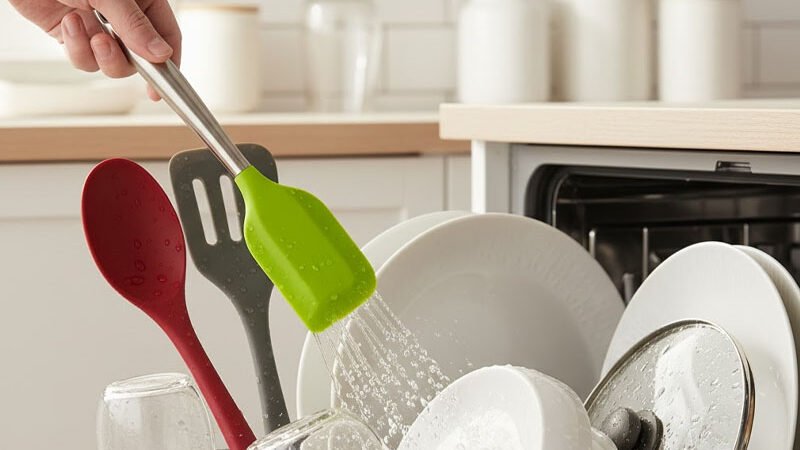
One of my favorite things about silicone is how easy it is to clean. I rinse utensils right after cooking, and most messes wipe off without soap. If they’re extra dirty, they go straight into the dishwasher.
Unlike wooden spoons, silicone tools won’t grow mold or split. And they don’t absorb strong smells from garlic or curry. Many also come with hanging loops, so I keep mine on a wall hook near the stove.
If drawer space is limited, use a countertop holder with drainage holes. Silicone tools don’t hold moisture, so they stay cleaner than wood or plastic.
Which Silicone Cooking Utensils Are Best for My Needs?
Your choice depends on how often you cook and what you cook most.
For everyday cooking, choose a basic set with a spatula, turner, and spoon. For baking or grilling, pick specialty tools like brushes, tongs, or scrapers.
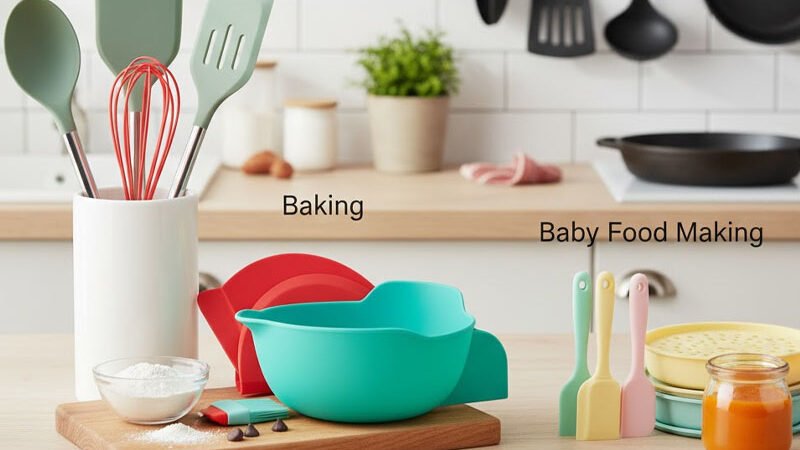
Here’s how I break it down for different needs:
| Cooking Style | Recommended Silicone Tools |
|---|---|
| Everyday Cooking | Spatula, turner, spoon |
| Baking | Whisk, scraper, brush |
| Stir-Fry or Grilling | Tongs, slotted turner, ladle |
| Meal Prep | Mixing spoon, spatula, measuring cups |
| Baby Food Making | Small spatula, heat-resistant spoon, steamer insert |
If you’re in product development, this versatility is useful. A single line of silicone tools can be adapted for multiple customer segments—family kitchens, bakers, or even professional chefs.
At RuiYang, we work with businesses to design utensil sets that fit their brand and target audience. We offer full customization, right down to the handle design and packaging.
Conclusion
Silicone cooking utensils offer the perfect mix of safety, durability, and ease of use—an essential upgrade for every modern kitchen.